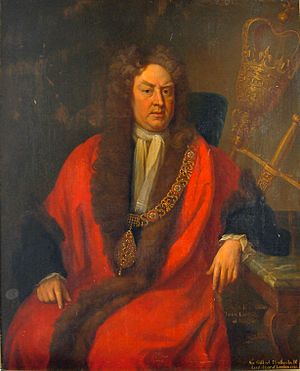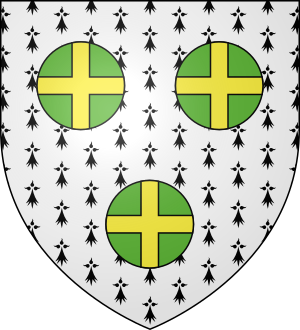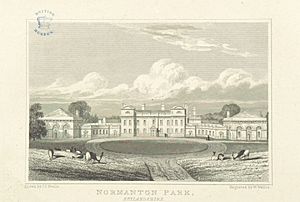Sir Gilbert Heathcote, 1st Baronet facts for kids
Quick facts for kids
Gilbert Heathcote
|
|
|---|---|
 |
|
| Sheriff of London | |
| In office 1703–1704 |
|
| Lord Mayor of London | |
| In office 1710–1711 |
|
| Preceded by | Sir Samuel Garrard |
| Succeeded by | Sir Robert Beachcroft |
| Governor of the Bank of England | |
| In office 1694–1733 |
|
| Member of Parliament for City of London |
|
| In office 1701–1710 |
|
| Member of Parliament for Helston |
|
| In office 1715–1722 |
|
| Member of Parliament for Lymington |
|
| In office 1722–1727 |
|
| Member of Parliament for St Germans |
|
| In office 1727–1733 |
|
| Personal details | |
| Born | 2 January 1652 Chesterfield, Derbyshire |
| Died | 25 January 1733 (aged 81) London, England |
| Political party | Whig |
| Spouse | Anne Goddard (m. 1765) |
| Children | 2, including Elizabeth |
Sir Gilbert Heathcote, 1st Baronet (born January 2, 1652 – died January 25, 1733) was an important English businessman and politician. He was a member of the Whig political party. He served in the British Parliament for many years, from 1701 to 1733. Sir Gilbert also held major roles as the governor of the Bank of England and as Lord Mayor of London in 1711.
Contents
Early Life and Business
Gilbert Heathcote was born in Chesterfield, Derbyshire. His father was also named Gilbert Heathcote. Gilbert learned about business by working as an apprentice overseas. In 1680, he came back to England. He started his own trading business in London.
In 1681, he became a member of the Vintners' Company. This was a group for wine merchants. He married Hester Rayner in 1682. His business focused on trading Spanish wines and other goods. He also started to get involved in local government. In 1689, he became a Common Councilman for Walbrook ward.
Gilbert Heathcote was an agent for Jamaica from 1693 to 1704. This meant he helped manage money for troops there. He also traded a lot with places in the East Indies.
Challenging Trade Rules
In 1693, a ship he partly owned, the Redbridge, was stopped. The East India Company claimed they had the only right to trade with India. Gilbert Heathcote argued that he should be allowed to trade freely. The Parliament agreed with him. They said that the company's monopoly (exclusive right) was wrong.
Heathcote then helped create a new East India Company. In 1694, he helped set up the Bank of England. He was chosen as a director of the bank. He stayed a director for most of his life. He also became treasurer of the Eastland Company in 1697. This company traded with countries in the Baltic Sea region.
Around 1698, Peter the Great, the Russian Emperor, visited London. Gilbert Heathcote spoke with him about importing tobacco into Russia. In 1698, Heathcote also invested a lot of money in the new East India Company. He helped manage this new company until 1704.
Political Career
Gilbert Heathcote tried to become a Member of Parliament (MP) for the City of London in 1698 but did not win. He joined the Russia Company in 1699. In 1700, he became the head of the Vintners' Company.
He was elected as an MP for the City of London in 1701. However, he was removed from Parliament soon after. This was because of his involvement with some financial papers called exchequer bills. But he was re-elected in a second election later that year.
Becoming a Knight and Sheriff
On June 30, 1702, Heathcote became an alderman for Walbrook. He was re-elected as an MP for London in 1702. Queen Anne knighted him on October 29, 1702. This happened during a special dinner at the Guildhall. He also helped manage the East India Company's trade from 1702 to 1704.
In 1703, he was elected as Sheriff of London. He had paid a fine in 1698 to avoid this job. But he served as Sheriff from 1703 to 1704. In 1705, he became a Fellow of the Royal Society. This is a group for important scientists.
From 1707 to 1710, he was a Colonel in the city's militia. He was also treasurer of the Honourable Artillery Company (HAC). In 1708, he was re-elected as an MP for the City of London. He became the governor of the Bank of England from 1709 to 1711.
Lord Mayor of London
In 1710, Gilbert Heathcote was next in line to become Lord Mayor of London. Some people, especially those connected to the royal court, did not want him to be mayor. They disliked a strong letter he had sent to the Queen. However, the city's aldermen still elected him. He served as Lord Mayor from 1710 to 1711.
He was not very popular with the public. His procession to Westminster as Lord Mayor was cut short. He was the last Lord Mayor to ride a horse in this procession.
He continued to hold important roles. He was vice-president of the HAC from 1711 to 1720. He also became a colonel again in the city militia in 1714. He kept this role for the rest of his life.
Later Years in Parliament
In 1715, Heathcote was elected as an MP for Helston. He also became a commissioner for building fifty new churches. By 1719, he was the Governor of the Eastland Company. He became president of the HAC in 1720. He held this position for the rest of his life.
In 1722, he was elected as an MP for New Lymington. He also became president of St Thomas' Hospital in 1722. He held this role for the rest of his life.
In 1725, he changed wards and became an Alderman for Bridge Without ward. He kept this role for the rest of his life. In 1727, he was elected as an MP for St Germans. In 1729, he bought Normanton Hall in Rutland.
In 1732, he became a commissioner for the new colony of Georgia in America. He helped get support for this project from his fellow directors at the Bank of England. Just eight days before he died, he was given the title of baronet. This made him Sir Gilbert Heathcote, 1st Baronet.
Gilbert Heathcote was very wealthy. However, some people, like the writer Pope, said he was very careful with his money. This might have made him unpopular with some people. He passed away in London on January 25, 1733. He was buried in Rutland. A special monument made by the sculptor Rysbrack is now in St Mary's Church in Edith Weston. His brother was Caleb Heathcote.
Links to the Slave Trade
Gilbert Heathcote owned shares in the South Sea Company (SSC). This British company was given permission by the Spanish Empire to transport enslaved people to Spanish colonies in America. This was part of the Atlantic slave trade.
However, according to research by University College London, Gilbert Heathcote himself did not own enslaved people in the British colony of Jamaica. Because of his connection to the South Sea Company, a school in Chesterfield named after him changed its name in 2021. It is now called the "Whittington Moor Nursery and Infant Academy."
Descendants
One of Gilbert Heathcote's descendants was Sir Gilbert John Heathcote, 5th Baronet (1795–1867). He was given the title Baron Aveland in 1856. His son, Gilbert Henry, later inherited another title and became the 1st Earl of Ancaster in 1892.
See also
- Heathcote (surname)
Images for kids




